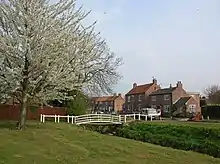| Wilberfoss | |
|---|---|
 The Village Inn | |
 Wilberfoss Location within the East Riding of Yorkshire | |
| Population | 1,866 (2011 census)[1] |
| OS grid reference | SE730508 |
| • London | 170 mi (270 km) S |
| Civil parish |
|
| Unitary authority | |
| Ceremonial county | |
| Region | |
| Country | England |
| Sovereign state | United Kingdom |
| Post town | YORK |
| Postcode district | YO41 |
| Dialling code | 01759 |
| Police | Humberside |
| Fire | Humberside |
| Ambulance | Yorkshire |
| UK Parliament | |
Wilberfoss is a village and civil parish in the East Riding of Yorkshire, England. It is situated on the north side of the A1079 approximately 8 miles (13 km) east of York city centre and 11 miles (18 km) north-west of Market Weighton. According to the 2011 UK census, Wilberfoss parish had a population of 1,866,[1] an increase on the 2001 UK census figure of 1,855.[2]

In 1823 inhabitants in the village numbered 335. Occupations included fifteen farmers, some of whom were land owners, three shopkeepers, two wheelwrights, two blacksmiths, a butcher, a bricklayer, a corn miller, a baker, a tailor, a wholesale brewer, and the landlords of the True Briton, Horse Shoes, and Waggon and Horses public houses. Also listed was one gentleman, a school teacher, and a perpetual curate. Baines' History, Directory & Gazetteer of the County of York states that the "ancient and respectable" family of Wilberfoss resided here from the Norman Conquest to 1710, after which the family estate and mansion was sold. A family descendant was William Wilberforce, and the Wilberforce family still provided patronage for the parish living. Wilberfoss Priory, a house of Benedictine nuns, was founded at Wilberfoss by Elias de Cotton during the reign of Henry II, which at the time of the Suppression of the Monasteries by Henry VIII had a yearly value of £26. 10s. 8d.[3] The priory lay just to the north of St John's Church; nothing of it remains today.[4]
In 1967 the parish Church of St John the Baptist was designated a Grade I listed building and is now recorded in the National Heritage List for England, maintained by Historic England.[5] Other notable buildings include the Grade II listed Old Vicarage (circa late 18th century) on Main Street, mentioned in Pevsner's account of the village for its remarkable dentilled timber eaves cornice and raised curved gables on shapes kneelers and Villa Farm also of Main Street.
Gallery
 St John the Baptist Church
St John the Baptist Church Shops on Main Street
Shops on Main Street Wilberfoss in the snow
Wilberfoss in the snow
References
- 1 2 UK Census (2011). "Local Area Report – Wilberfoss Parish (1170211288)". Nomis. Office for National Statistics. Retrieved 27 February 2018.
- ↑ UK Census (2001). "Local Area Report – Wilberfoss Parish (00FB159)". Nomis. Office for National Statistics. Retrieved 24 April 2019.
- ↑ Baines, Edward (1823). History, Directory & Gazetteer of the County of York. pp. 399, 400. ISBN 1230139141.
- ↑ Pevsner, Nikolaus (1975) [1972]. The Buildings of England. Yorkshire: York and the East Riding (reprint). Pevsner Architectural Guides. Penguin. p. 369. ISBN 0140710434.
- ↑ Historic England. "Church of St John the Baptist (1162096)". National Heritage List for England. Retrieved 10 August 2013.
- Gazetteer — A–Z of Towns Villages and Hamlets. East Riding of Yorkshire Council. 2006. p. 11.
External links
![]() Media related to Wilberfoss at Wikimedia Commons
Media related to Wilberfoss at Wikimedia Commons